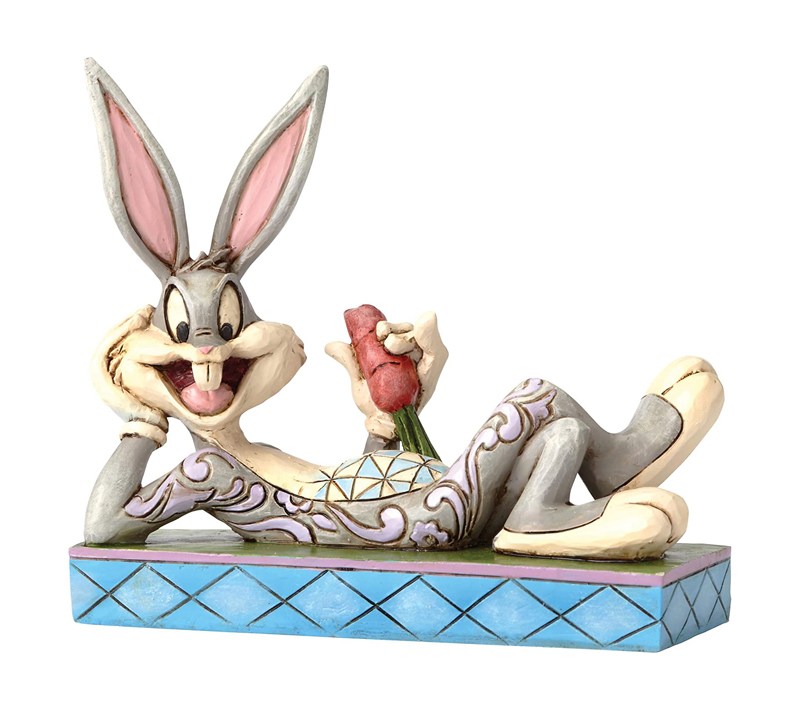Looney Tunes’ Bugs Bunny Statue
Cool as a carrot from the Looney Tunes by Jim Shore line, comes this Bugs Bunny Personality Pose Statue that combines classic Looney Tunes characters with folk art designs. This statue captures Bugs Bunny with beautiful handcrafted details in high-quality stone resin and hand-painted. This Bugs Bunny Personality Pose captures the light-hearted essence of that rascally wabbit, as he kicks back to crunch down on a tasty carrot. Jim Shore’s signature colours and unique folk art style lend a timeless touch. Bugs Bunny is an animated cartoon character created in the late 1930s by Leon Schlesinger Productions (later Warner Bros. Cartoons) and voiced originally by Mel Blanc. Bugs is best known for his starring roles in the Looney Tunes and Merrie Melodies series of animated short films, produced by Warner Bros. Though a similar character first appeared in the WB cartoon Porky’s Hare Hunt (1938) and a few subsequent shorts, the definitive characterization of Bugs Bunny is widely credited to have debuted in director Tex Avery’s Oscar-nominated film A Wild Hare (1940). Bugs is an anthropomorphic gray and white rabbit or hare who is famous for his flippant, insouciant personality. He is also characterized by a Brooklyn accent, his portrayal as a trickster, and his catch phrase “Eh…What’s up, doc?“.
Due to Bugs’ popularity during the golden age of American animation, he became not only an American cultural icon and the official mascot of Warner Bros. Entertainment, but also one of the most recognizable characters in the world. He can thus be seen in the older Warner Bros. Company logos. Bugs Bunny starred in more than 160 cartoon shorts produced between 1940 and 1964. He has since appeared in feature films, compilation films, TV series, music records, comics, video games, award shows, amusement park rides, and commercials. He has also appeared in more films than any other cartoon character, is the 9th most-portrayed film personality in the world. Like Mickey Mouse for Disney, Bugs Bunny has served as the mascot for Warner Bros. and its various divisions. According to Guinness World Records, Bugs has appeared in more films (both short and feature-length) than any other cartoon character. On December 10, 1985, Bugs became the second cartoon character (after Mickey) to receive a star on the Hollywood Walk of Fame. He also has been a pitchman for companies including Kool-Aid and Nike. His Nike commercials with Michael Jordan as “Hare Jordan” for the Air Jordan VII and VIII became precursors to Space Jam.
As a result, he has spent time as an honorary member of Jordan Brand, including having Jordan’s Jumpman logo done in his image. In 2015, as part of the 30th anniversary of Jordan Brand, Nike released a mid-top Bugs Bunny version of the Air Jordan I, named the “Air Jordan Mid 1 Hare“, along with a women’s equivalent inspired by Lola Bunny called the “Air Jordan Mid 1 Lola“, along with a commercial featuring Bugs and Ahmad Rashad. In 2002, TV Guide compiled a list of the 50 greatest cartoon characters of all time as part of the magazine’s 50th anniversary. Bugs Bunny was given the honor of number 1. In a CNN broadcast on July 31, 2002, a TV Guide editor talked about the group that created the list. The editor also explained why Bugs pulled top billing: “His stock… has never gone down… Bugs is the best example… of the smart-aleck American comic. He not only is a great cartoon character, he’s a great comedian. He was written well. He was drawn beautifully. He has thrilled and made many generations laugh. He is tops“. Some have noted that comedian Eric Andre is the nearest contemporary comedic equivalent to Bugs. They attribute this to, “their ability to constantly flip the script on their unwitting counterparts”. Looney Tunes’ Bugs Bunny Statue sizes: 4 inches / 10 cm x 1.5 inches / 4 cm x 3.75 inches / 9.5 cm.
Bugs Bunny Personality Pose Statue on Amazon.
Bugs Bunny Personality Pose Statue on eBay.
Cartoons Statues and Looney Tunes Statues.






You must be logged in to post a comment.